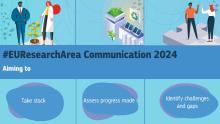Since 25 years, the European Research Area is the ambition to allow the emergence of an integrated European system of research and innovation that delivers scientific and technological solutions to European societies and to the world. The anniversary video exemplifies major achievements of the ERA over the last quarter of a century.
The launch of a new research and innovation era in 2000
The European Research Area (ERA) was launched in 2000 with the aim of creating a single market for research and innovation fostering free movement of researchers, scientific knowledge and innovation, and fostering a more competitive European industry. To reach these objectives the European research landscape needed to be oriented towards more cross-border cooperation, continent-wide competition, building of critical mass and coordination, and the improvement of national research policies and systems. The importance of these efforts has been highlighted in 2009, when achieving the ERA has also become an explicit Treaty objective, as expressed in Article 179 TFEU.
ERA yielded major achievements since 2000
Since 2000, the European Research Area has seen major achievements: The work of the European Strategy Forum on Research Infrastructures (ESFRI) resulted in the development of plans for more than 50 European Research Infrastructures, across all fields of science, mobilising close to EUR 20 billion in investments. Jointly addressing common challenges through coordination and pooling of resources has resulted in more than EUR 7 billion of national investments in joint research programmes, with current annual joint spending of EUR 800 million. Significant progress has been made in removing the geographical barriers to researchers’ mobility and the fragmentation of research careers in Europe, driven by the European Charter for Researchers and a Code of Conduct for the Recruitment of Researchers. In addition, the EURAXESS initiative supports researcher mobility and career development by delivering information and support services to professional researchers. The ERA has enhanced access to open, free of charge, re-usable scientific information through the Open Science initiative and the European Open Science Cloud (EOSC) creating a cloud area for research data in Europe allowing for better science through open and collaborative knowledge sharing.
Re-vitalising the European Research Area since 2018
Despite this progress, discussions were evolving about re-vitalising the ERA since 2018, giving it more visibility, relevance and effectiveness. To this end, the Council of the EU and the European Commission initiated a process to renew the ERA and to establish a more effective ERA governance. In November 2021, the Council adopted a Pact for Research and Innovation in Europe as the foundation of the "new ERA" as well as a new governance framework for its implementation. Furthermore, the Council adopted a first ERA Policy Agenda for the years 2022-2024 and called on the EU Member States and the European Commission to work together in partnership towards its implementation. In October 2024, the European Commission has adopted a Communication on the implementation of the European Research Area. This Communication assesses the progress made over the past four years and highlights the areas where further work is needed to build a more integrated, efficient, and inclusive research and innovation system across the EU. The next ERA Policy Agenda for 2025-2027 will build on these experiences and can be expected for May 2025.
The ‘Letta report’ on reforming the Single Market, published in April 2024, provides a significant political boost for the further implementation of the ERA and its ERA Policy Agendas. The ‘Letta report’ strongly re-confirms the benefits of establishing a “5th freedom to enhance research, innovation and education in the Single Market”, which is enshrined in the Article 179(1) TFEU stating as objective “a European research area in which researchers, scientific knowledge and technology circulate freely”.
In January 2025, the Commission has announced an ERA Act as one of the Flagship Actions in the Competitiveness Compass, the Commission's strategic framework to steer its work during the term 2024-2029. In February 2025, the Commission has tabled its Proposal for a Council Recommendation on the European Research Area Policy Agenda 2025-2027 and the related list of proposed initiatives.
Have a look at our Factsheet on the history of the ERA!

